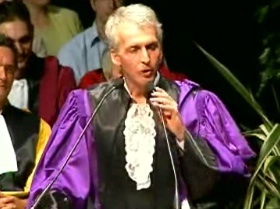The Revival of the Cult of Martin of Tours in the Third Republic
The Revival of the Cult of Martin of Tours in the Third Republic
Journal article by Brian Brennan; Church History, Vol. 66, 1997
Journal Article Excerpt
The Revival of the Cult of Martin of Tours
in the Third Republic
BRIAN BRENNAN
Statuary groups, countless illustrations, and colorful stained glass all preserve
for us the most famous medieval image of the charitable soldier-saint, Martin of
Tours (336-397). The young Martin is depicted seated on his horse dividing his
soldier's cape to share it with Christ disguised as a freezing beggar at the gate of
Amiens.1 After abandoning the Roman army, Martin became a monk, an ascetic
"soldier of Christ," and was chosen by the people of Tours as their bishop.
Renowned in his lifetime as a wonderworker, Martin's tomb remained for
centuries an important pilgrimage center. The later Carolingian kings carried a
fragment of Martin's cape into battle as a victory-giving talisman, and French
monarchs invoked the saint as their patron. Because of its royalist associations,
Saint Martin's basilica at Tours was almost completely destroyed in the French
Revolution, and subsequently houses and new municipal streets encroached on
the sacred space.
The medieval cult of Martin has been extensively studied, but the issues
raised by the nineteenth-century revival of the cult, at the site of the tomb that
was dramatically rediscovered on 14 December 1860, have so far gone unex
plored. This study seeks to investigate this modern revival and the process by
which the cult, initially promoted by royalists, was gradually accommodated to
modern French nationalism and republicanism. It demonstrates that Martin's
renewed popularity was due in large measure to his successful promotion as a
military saint during both the Franco-Prussian War of 1870-1871 and the First
World War.
1.
In the military and political crisis of the Franco-Prussian War, the Second
Empire, which had been established by Napoleon III in 1852, swiftly collapsed.
Following the ignominious capitulation of the emperor himself to the Prussians
after the Battle of Sedan in September 1870, a provisional government of
national defense was established and a republic, France's third, hastily pro
claimed. Paris was evacuated in the face of the enemy advance, and for a brief
Mr. Brennan is an honorary associate in the school of history, Macquarie University,
Sydney, Australia.
____________________
1 Boris Lossky and Jean-Marie Girard, eds., Saint Martin dans l'art et l'imagerie: Exposition
national, Musée des Beaux-arts. Du 7 Juillet au Ier Octobre (Tours, France, 1961 ).
Journal article by Brian Brennan; Church History, Vol. 66, 1997
Journal Article Excerpt
The Revival of the Cult of Martin of Tours
in the Third Republic
BRIAN BRENNAN
Statuary groups, countless illustrations, and colorful stained glass all preserve
for us the most famous medieval image of the charitable soldier-saint, Martin of
Tours (336-397). The young Martin is depicted seated on his horse dividing his
soldier's cape to share it with Christ disguised as a freezing beggar at the gate of
Amiens.1 After abandoning the Roman army, Martin became a monk, an ascetic
"soldier of Christ," and was chosen by the people of Tours as their bishop.
Renowned in his lifetime as a wonderworker, Martin's tomb remained for
centuries an important pilgrimage center. The later Carolingian kings carried a
fragment of Martin's cape into battle as a victory-giving talisman, and French
monarchs invoked the saint as their patron. Because of its royalist associations,
Saint Martin's basilica at Tours was almost completely destroyed in the French
Revolution, and subsequently houses and new municipal streets encroached on
the sacred space.
The medieval cult of Martin has been extensively studied, but the issues
raised by the nineteenth-century revival of the cult, at the site of the tomb that
was dramatically rediscovered on 14 December 1860, have so far gone unex
plored. This study seeks to investigate this modern revival and the process by
which the cult, initially promoted by royalists, was gradually accommodated to
modern French nationalism and republicanism. It demonstrates that Martin's
renewed popularity was due in large measure to his successful promotion as a
military saint during both the Franco-Prussian War of 1870-1871 and the First
World War.
1.
In the military and political crisis of the Franco-Prussian War, the Second
Empire, which had been established by Napoleon III in 1852, swiftly collapsed.
Following the ignominious capitulation of the emperor himself to the Prussians
after the Battle of Sedan in September 1870, a provisional government of
national defense was established and a republic, France's third, hastily pro
claimed. Paris was evacuated in the face of the enemy advance, and for a brief
Mr. Brennan is an honorary associate in the school of history, Macquarie University,
Sydney, Australia.
____________________
1 Boris Lossky and Jean-Marie Girard, eds., Saint Martin dans l'art et l'imagerie: Exposition
national, Musée des Beaux-arts. Du 7 Juillet au Ier Octobre (Tours, France, 1961 ).


